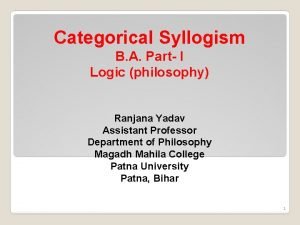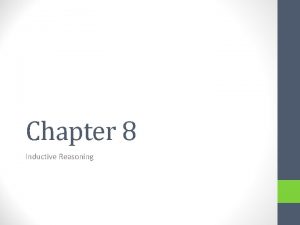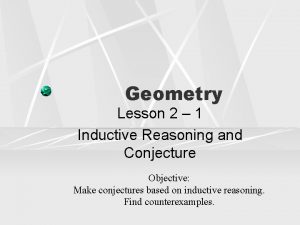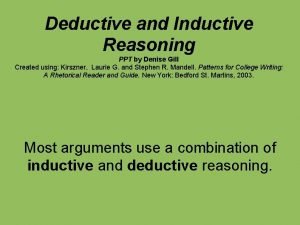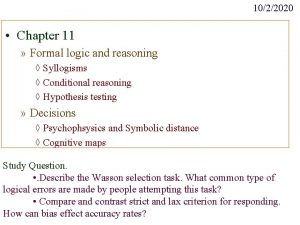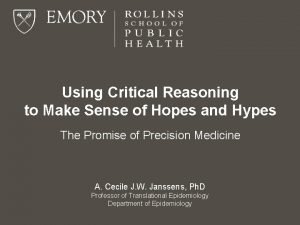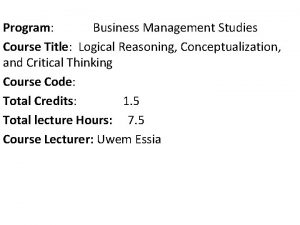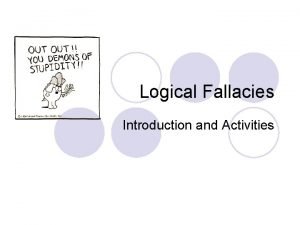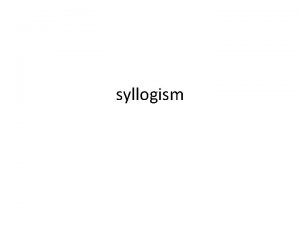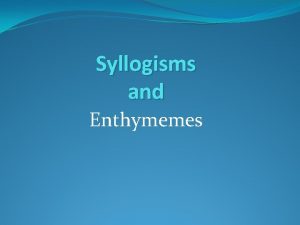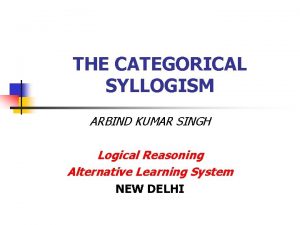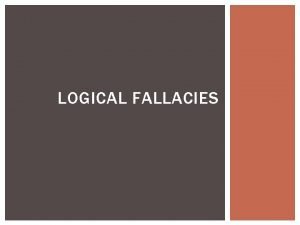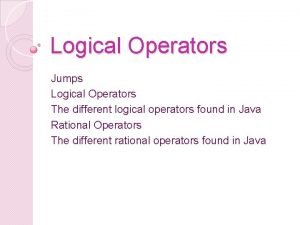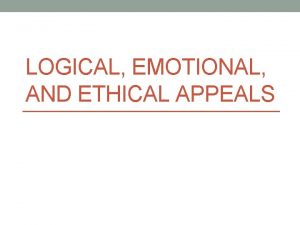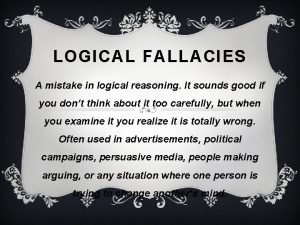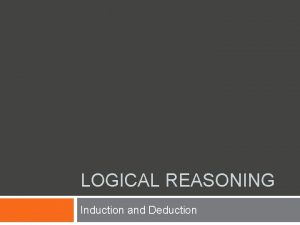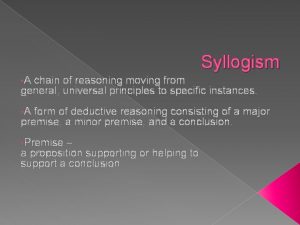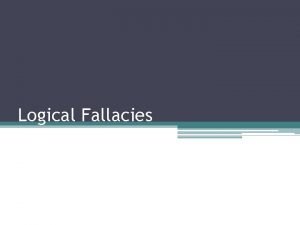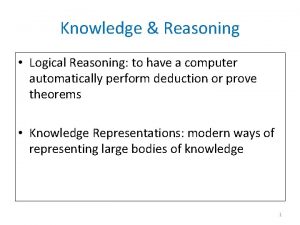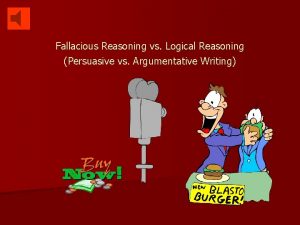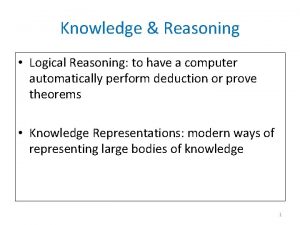SYLLOGISM FORM LOGICAL REASONING WHAT IS A SYLLOGISM

















- Slides: 17

SYLLOGISM - FORM & LOGICAL REASONING

WHAT IS A SYLLOGISM? • Syllogism – the formal structure of logical argument. • Three statements - Major Premise, Minor Premise, and Conclusion. • Major Premise – general statement, assumed true. • Minor Premise – specific statement, assumed true • Leading to a logical conclusion based on the premises.

THREE TYPES OF SYLLOGISMS • What structures / forms of reasoning are true? • Three different kinds of syllogism: 1. Categorical 2. Conditional 3. Disjunctive

THREE TYPES OF SYLLOGISMS • What structures / forms of reasoning are true? • Three different kinds of syllogism: 1. Categorical – (all / every) 2. Conditional – (if / then) 3. Disjunctive – (either / or) Based on different premises in the assumption.

CATEGORICAL (ALL / EVERY) • Something true about all members of a category must be true about a particular example. • Expressed using variables: Major: A is true about B. Minor: C is equivalent to B. Conclusion: A is also true about C. • Example: Major: All men are mortal. Minor: Socrates is a man. Conclusion: Therefore, Socrates must be a mortal.

PRACTICE: • Finish the Categorical Syllogism: Major: All dogs go to heaven. Minor: ___________________. Conclusion: Therefore, ___________.

CONDITIONAL (IF / THEN) • If a first assumption proves to be true, then a logically related assumption must also be true. • Expressed using variables: Major: If A is true, then B is true as well. Minor: A is true. Conclusion: B must be true as well. • Example: Major: Where there’s smoke, there’s fire. Minor: There is smoke. Conclusion: Therefore, there must be a fire.

PRACTICE: • Finish the Conditional Syllogism: Major: If I am late to work, I’ll get in trouble. Minor: ___________________. Conclusion: Therefore, ___________.

DISJUNCTIVE (EITHER / OR) • If a first assumption proves to be true, then a related but contradictory assumption must be false. • Expressed using variables: Major: If A is true, then B must be false. Minor: A is true. Conclusion: B must be false then. • Example: Major: Either I pay more taxes, or get audited by the IRS. Minor: I did pay my taxes. Conclusion: Therefore, I won’t be audited by the IRS.

PRACTICE: • Finish the Disjunctive Syllogism: Major: Either I spend the whole weekend playing video games, or I do some studying. Minor: ___________________. Conclusion: Therefore, ___________.

ABBREVIATED SYLLOGISMS • When people speak, they don’t articulate the full logical structure of their reasoning. • Mr. Burtosky might say: “The substitute is a teacher, so give her the same respect while I’m gone. • The logic underlying this statement is: Major: You should respect your teachers. Minor: The substitute is a teacher. Conclusion: You should respect her too. • What statement was left out in what Mr. Burtosky said?

ENTHYMEME • Enthymeme – an abbreviated syllogism, where one of the premises making up a logical deduction is left unstated. • Etymology – Enthymeme is Greek for “in-the-mind”. • The missing premise is inferred by the audience listening to the argument.

CONVERTING ENTHYMEMES - EXAMPLE • If I say “Max is originally from Canada, so he really likes maple syrup. ” Major Premise: All Canadians like maple syrup. Minor Premise: Max is a Canadian. Conclusion: Therefore, Max likes maple syrup. • If I say “The only thing that matters is the number of games, that’s why the PS 4 is best console. ” Major Premise: The console with the most games is the best. Minor Premise: The PS 4 has more games than any other console. Conclusion: Therefore, the PS 4 is the best console.

CONVERTING ENTHYMEMES - PRACTICE • Jace is on the speech and debate team, so he must be good at public speaking. ” Major Premise: _____________________. Minor Premise: _____________________. Conclusion: Therefore, _________________. • We should go to fast food place with the best breakfast, which means we should go to Jack in the Box. ” Major Premise: _____________________.

CONCLUSION • A syllogism is the formal structure of logical argument. • Made up of three parts, a major premise, minor premise, and conclusion. • Three kinds of syllogisms, categorical (every / all), conditional (if / then), and disjunctive (either / or). • An enthymeme is an abbreviated syllogism, with one premise unstated and assumed by the audience.


ASSIGNMENT INSTRUCTIONS • To demonstrate your knowledge of logical reasoning, you will identify and analyze the ENTHYMEME (abbreviated argument) being communicated by a magazine advertisement: • Select a magazine advertisement. • Cut it out, and tape / glue it to a piece of notebook paper. • Summarize the advertisement’s message (complete sentence). • Re-write that message as a syllogism (major, minor, conclusion). • Identify which premise was left unstated - the inference.
 Logical form and logical equivalence
Logical form and logical equivalence Kesetaraan logis
Kesetaraan logis Logical syllogism
Logical syllogism Statistical syllogism example
Statistical syllogism example 2-1 inductive reasoning and conjecture
2-1 inductive reasoning and conjecture Inductive and deductive reasoning math ppt
Inductive and deductive reasoning math ppt Logic reasoning
Logic reasoning Kahulugan ng argumento
Kahulugan ng argumento What is logical reasoning
What is logical reasoning This restates the argument rather than actually proving it
This restates the argument rather than actually proving it Structure of a deductive argument
Structure of a deductive argument Problem solving
Problem solving Deductive vs inductive reasoning
Deductive vs inductive reasoning Deductive reasoning definition
Deductive reasoning definition Deductive method
Deductive method Every quiz has been easy. therefore, the test will be easy.
Every quiz has been easy. therefore, the test will be easy. Inductive vs deductive geometry
Inductive vs deductive geometry Inductive reasoning patterns
Inductive reasoning patterns


